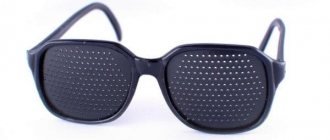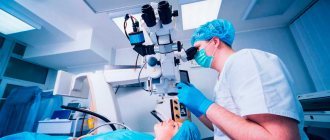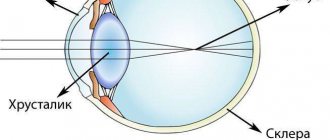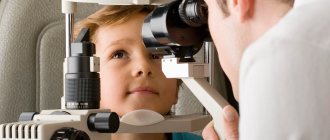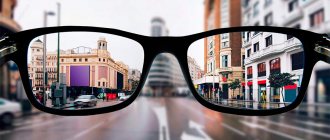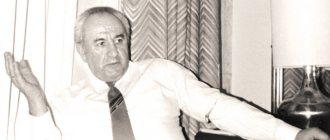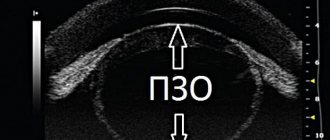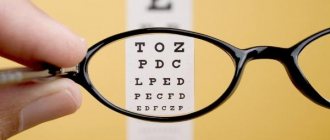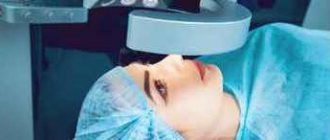Myopia is the most common diagnosis given by ophthalmologists to school-age children and adolescents. Sometimes visual impairments are discovered by chance, during a routine examination, and sometimes the child himself notes that his vision has become worse and informs his parents about this. It will be useful to learn about the most modern treatments for myopia and measures to prevent its occurrence.
Main symptoms
The main symptom of myopia is decreased visual acuity in relation to objects located at a distance. This occurs because light rays are focused in front of the retina rather than on it. For example, a student may note that, being in the back desks, he cannot clearly see what is written on the board, and has difficulty trying to see price tags in a store.
The school board looks blurry if you are nearsighted.
The following symptoms may also occur:
- pain in the eyes caused by overstrain of the eye muscles, occurring in the evening;
- headache;
- sensation of fog before the eyes.
The sooner the first signs of the disease are noticed, the sooner the need for treatment will become obvious.
Separately, it is worth highlighting false myopia in school-age children or pseudomyopia. It occurs due to spasm of the ciliary muscle of the eye. False myopia has the same symptoms as true myopia, but does not require medication or surgery. Only a professional examination by a doctor will help you distinguish one disease from another.
Treatment of anisometropia
The main method of treatment is surgery. It is resorted to only in cases where the correction has not produced results or the disease is in a very advanced stage. Laser vision correction occurs. Such measures are taken only after the recommendation of a specialist.
It is also worth considering that the operation has contraindications and limitations. If corneal diseases are present, laser vision correction is not possible. During the operation, vision is corrected using special equipment. After surgery, you should not put strain on your eyes. Concussions and injuries should be avoided, otherwise the disease will progress.
Before starting treatment for anisometropia, you should consult a specialist and get tested
It is very important to follow all recommendations of specialists in the postoperative period. This will increase your chances of recovery
Causes of myopia in schoolchildren
The following possible causes of myopia are distinguished:
- insufficient illumination of the child’s workplace;
- chronic fatigue;
- too much strain on the visual apparatus;
- habit of spending a long time in front of a computer or TV;
- too poor nutrition, pronounced vitamin deficiency.
To maintain visual function, consuming foods that contain vitamin A is of great importance.
Nowadays, most children have various electronic devices. Their improper use can lead to vision impairment. For example, many teenage students actively use e-books for reading. But if you make the screen too dim or too bright, or set the font too small, your eyes will be strained.
In the development of myopia, the hereditary factor is of great importance. Premature babies born before the 36th week of pregnancy also often have vision problems. Often, myopia is diagnosed before they reach school age.
False myopia in children and its treatment
Impaired functioning of the eye muscle, which normally provides the ability to clearly examine objects regardless of distance, is a false form. When the accommodative muscle spasms, visual acuity decreases.
It appears in schoolchildren. This is facilitated by visual stress, poor lighting of the workplace, weakened tone of the neck and back muscles, improper daily routine, physical fitness, unbalanced diet, non-compliance with visual hygiene rules, and psychological imbalance of the child.
It manifests itself as a deterioration in visual acuity, severe headaches, pain in the temples, forehead, eyes, and fatigue. It is reversible, treatment restores vision. If detected late and not treated properly, it can become true myopia.
Treatment of school myopia with medications
To treat myopia in children and adolescents, doctors use drugs from various groups:
- Means that improve blood circulation inside the eye. Emoxipin eye drops and Trental tablets. They resolve minor hemorrhages, protect the eyes from harmful ultraviolet exposure, strengthen blood vessels, and prevent oxygen starvation of tissues.
- Agents that improve internal microcirculation of intraocular fluid. They promote more efficient fluid outflow, dilate the pupil and constrict the blood vessels of the conjunctiva. These include drops “Irifrin”, “Mezaton”.
Treatment is also carried out with Taufon drops. They restore the cell membranes of eye tissue, provide them with nutrients, and accelerate recovery processes. Taking calcium supplements is of great importance. Calcium strengthens the eye muscles, and thereby inhibits the development of the disease.
Treatment of false myopia is carried out with cycloplegic drugs, for example, Atropine or Tropicamide drops. They act on special receptors located in the ciliary muscle and iris. As a result, the muscle relaxes and the pupil dilates.
Treatment of myopia in children and adolescents of school age must be carried out under the supervision of a doctor. The specialist should monitor the development of positive dynamics and, if necessary, adjust the treatment plan.
Glasses and lenses are the easiest way to correct
To select glasses and lenses, the ophthalmologist must conduct preliminary studies:
- Visometry is the study of visual acuity using a letter table.
- Computer refractometry. This is a diagnostic study of the ratio of the refractive power of the eye to its longitudinal axis. The procedure allows you to detect myopia even at the earliest stages. At the same time, astigmatism can be diagnosed.
What exactly to choose, glasses or contacts, should be discussed with your doctor. The glasses are easy to use, do not require direct contact with the surface of the eyeball, and can be used for a long time if handled with care. Their disadvantages include: difficulties when engaging in active sports and in bad weather conditions, limitation of lateral fields of vision.
Contact lenses can be worn when playing sports and do not interfere with the use of sunglasses. Their disadvantages are: the possibility of allergic reactions, the need for very careful and careful care, and high cost. Contraindications to the use of contact lenses are: strabismus, infectious or inflammatory eye disease, development of glaucoma.
Read in a separate article: Stye on a child’s eye: what to do, how and with what to treat children
Myopia in childhood: progressive myopia in children
The progressive form occurs during rapid growth of the body - the baby’s body is actively growing, the next school year increases visual stress. When the degree increases by more than 1D over the course of a year, it is called progressive.
If treatment is not started on time, it can reach 10D by the age of 18. Treatment of progressive myopia is required; it can lead to loss of ability to work and disability. Children with visual impairments are prohibited from playing sports, as they can cause retinal detachment.
Progressive myopia occurs in newborns - congenital, hereditary. The first develops as a result of underdevelopment and diseases in the antenatal period. It is observed in those who have had a mild form of retrolental fibroplasia.
The reason for the development of the disease is a significant lengthening of the eye axis: instead of 22-23 mm, it reaches 30-32 mm or more. The size is determined using an echoophthalmograph. When myopia progresses more than 1 D annually, it is considered malignant.
Progressive myopia is accompanied by pathological changes in the optic nerve, retina, vitreous body, the periphery of the fundus in the form of racemose retinal degeneration, and many small defects of round, oval, slit-like shape.
Progressive pathology can be stopped using laser coagulation of the retina. The laser is highly accurate. Used to strengthen the retina - to create adhesions between the retina and the choroid of the eye. The procedure takes no more than 15 minutes, is performed without hospitalization, under local drip anesthesia, and eliminates pain.
A reliable, effective surgical method, scleroplasty, helps to stop the development of a progressive form, aimed at strengthening the outer shell of the eye, increasing the number of vessels feeding the posterior pole of the eyeball, improving blood supply.
A progressive anomaly cannot be ignored. Over time, it can lead to a significant decrease in vision and irreversible changes in the retina.
Treatment with folk remedies
Here are several recipes for treating myopia using traditional medicine intended for school-age children and adolescents:
- Prepare freshly squeezed blueberry juice. Dilute with boiled water in a 1:1 ratio. Apply into eyes twice a day.
- Mix 250 g of fresh lingonberries and 150 g of honey of any kind. Take the product on an empty stomach, 3 tbsp. l.
- Dilute freshly squeezed aloe juice with boiled water and liquid honey. Place 2-3 drops into your eyes in the morning.
- Take 1 tbsp internally. l. sea buckthorn oil.
If these remedies are not effective and the child’s vision continues to deteriorate, you should consult a doctor.
How is myopia diagnosed?
An ophthalmologist deals with eye diseases and, seeing the patient for the first time, he carries out the following procedures as part of a diagnostic procedure:
- Survey of parents and the child himself. This helps to find out how long ago the first signs of vision deterioration appeared, how quickly the child’s eyes get tired when reading or watching TV/computer, and whether there are or are not associated symptoms of myopia (for example, regular headaches, general malaise).
- Examination of the child:
external examination of the eye - the shape and size of the eyeball is determined;
- examination with an ophthalmoscope – the size and shape of the cornea is determined, the condition of the lens and vitreous body is assessed, and the fundus is examined. In the latter case, atrophic changes, pigmentation, hemorrhages, and retinal detachment may be detected;
- assessing the degree of myopia and type of refraction - skiascopy;
- Ultrasound examination - complications of myopia are revealed.
Please note: in patients under 3 years of age, doctors use only the listed diagnostic methods, but be sure to carry out comparative work with the results of examinations at 3 and 6 months (they are required for every child).
For children over 3 years old, visual acuity is determined using special tables; the same examination allows you to select lenses for vision correction.
In some cases, skiascopy is replaced by autorefractometry - a solution of atropine is instilled into the child’s eyes and the fundus is examined using a slit lamp.
Schoolchildren are at risk for developing myopia, so they should be examined every 6 months. Even if myopia was detected at the first appointment, you should not think that this disorder is forever - it is quite possible that this is a temporary phenomenon and is associated with the growth of the eye. In this case, frequent preventive examinations by an ophthalmologist will help to timely detect the onset of disease progression and take effective measures.
Doctors believe that an increase in myopia by 0.5 diopters per year indicates a slow progression of the disease, but if this figure exceeds 1 diopter per year, then it’s time to “sound the alarm.” Against the background of such a rapid decrease in vision, complications of myopia can develop - hemorrhages in the retina, retinal tears and detachments, destructive changes, which are irreversible processes.
Healthy foods and vitamins
If a student has been diagnosed with myopia, he needs a healthy, varied diet. The daily menu should satisfy the body's need for vitamins A and D and microelements such as magnesium, copper and zinc.
The children's diet should include the following foods rich in vitamins for school-age children and adolescents with myopia:
- whole grain bread or bran bread;
- fresh non-starchy vegetables, best seasonal, and fresh herbs;
- whole grain pasta or durum wheat pasta;
- buckwheat;
- citrus fruits and berries: blueberries, lingonberries, blackberries;
- fermented milk products.
Vegetable fats in the form of nuts and any vegetable oil must be present in the diet. To prevent myopia, doctors can prescribe a vitamin complex to a schoolchild. You need to take such drugs in courses, strictly following the instructions. It is not recommended to choose a vitamin for your child on your own.
Surgery
Treatment with surgical methods is used if conservative therapy does not produce results. Myopia in school-age children and adolescents can be eliminated using the following methods:
- Laser vision correction. Laser beams align the cornea, causing light rays to be refracted correctly and fixed directly on the retina.
- Scleroplasty. It is performed through intraocular injections. A special synthetic gel is injected into the eye. This operation inhibits the increase in the length of the eyeball. Scleroplasty is used by doctors for rapid progression of myopia.
- Keratotomy. Small, non-through incisions are made at the edges of the cornea. The cornea becomes denser, due to which its refractive power decreases.
After surgical treatment, the child will need time for complete rehabilitation, from 1 to 3 weeks. Immediately after surgery, a sterile bandage is applied to the eye. During the entire recovery period, it is necessary to use moisturizing eye drops and take anti-inflammatory drugs.
Laser correction
Children's laser vision correction is considered an excellent alternative to glasses. Previously, this procedure was performed only after 18 years of age, but now it has been proven that with farsightedness and astigmatism, the formation of the eyeball is completely completed by the age of 10.
Before laser correction, the child should be observed by an ophthalmologist for at least 2-3 years; treatment during this period is aimed at stabilizing myopia. There should be no abnormalities in the fundus.
The laser evaporates part of the cornea, it becomes thinner, and the light rays passing through it are focused precisely on the retina. After the procedure, regular monitoring is necessary; as the child grows and if there are no changes in the fundus, correction can be continued.
Laser correction is used for stable myopia, farsightedness and astigmatism. Correction of visual function is approaching ideal, but the shape of the eyeball does not change.
Eye gymnastics is a powerful remedy
One of the powerful means of preventing the development of myopia is therapeutic exercises. All school-age children should master it.
You need to do the following exercises:
- Close your eyes intensely for 3-5 seconds, then rest for the same amount of time. Perform the exercise for a couple of minutes in a sitting position, your back should be straight;
- stick any sticker on the window glass. Move one and a half meters away, alternately fix your gaze on the mark and on objects located outside the window;
- look from top to bottom, then from right to left;
- bring your eyes together several times, focusing your gaze on the bridge of your nose;
- Massage your closed eyelids with your fingertips for a couple of minutes;
- extend your right hand in front of you, raise your thumb up so that it is at the level of your nose. Focus your gaze on your thumb, slowly move your hand towards your face, and then move it away. Repeat the exercise with your left hand.
useful gymnastics for the eyes
These simple actions increase blood circulation, relax and at the same time train muscles, maintaining visual acuity at the same level. Schoolchildren can do gymnastics during breaks between lessons.
Prevention of myopia in students
Prevention of myopia in school-age children comes down to minimizing the load on the visual system. To do this, you must follow the following rules:
- Do not read lying down or in poor lighting. The eyes have to strain a lot, they get tired quickly. Daylight is the most gentle for vision. It is advisable to install a fluorescent lamp in the child's room.
- When working at a computer or doing homework, you need to take a short break every 45-50 minutes. You can spend a few minutes doing visual gymnastics or just relaxing with your eyes closed.
- The distance from your eyes to the computer should be at least 30 cm.
Author of the article: Elizaveta Viktorovna Klokova, specialist for the website glazalik.ru Share your experience and opinion in the comments.
